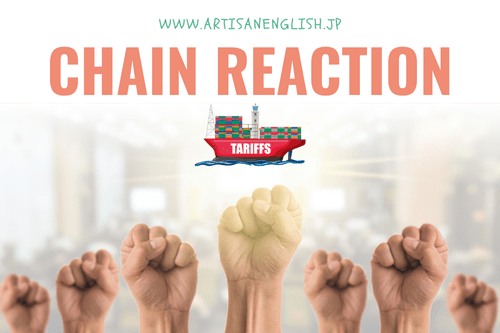
YouTube / iTunes / Spotify / Radio Public / Pocket Casts / Google Podcasts / Breaker / Overcast
Listen to ArtisanEnglish.jp posts & lesson intros here.
WotD: Chain reaction
A chain reaction is a series of events where one action causes another, leading to a cascade of effects.
This concept often comes into play in global economics, especially when discussing tariffs and trade relations.
Let’s take a closer look at a situation where a tariff of 145% is imposed on Chinese goods by the United States, effectively starting a trade war.
Unfortunately, this is not a hypothetical situation.
This drastic move could trigger a chain reaction with wide-reaching consequences.
First, China might respond by imposing tariffs on American products, which it did.
This retaliation could lead to a series of trade barriers, creating a chain reaction that disrupts global markets, which is occurring as you read this post.
As trade slows down, economies around the world may suffer.
Jobs could be lost, and prices for consumer goods could rise.
This is happening now.
This economic turmoil may lead to social unrest, igniting discontent among affected populations.
The chain reaction of frustration and financial hardship could influence political decisions, with countries needing to act more aggressively to defend their interests.
Countries allied with the U.S. or China might also be pulled into this chain reaction.
They may choose sides, imposing tariffs or sanctions based on their alliances and economic goals.
Donald Trump has imposed tariffs on every country worldwide, so this may not occur.
This could further escalate tensions, making conflicts more likely.
If negotiations fail, the chain reaction could spiral beyond trade wars into military conflicts, raising fears of a world war.
In conclusion, the idea of a chain reaction highlights how interconnected our world is.
A seemingly isolated act, like a high tariff, can ignite a series of events that lead to significant global consequences.
Understanding this concept is essential for grasping the complexities of international relations and the potential for conflict in our interconnected world.
Flesch-Kincaid Readability Test
This post is understandable by someone with at least a 9th-grade education (age 15).
On the Flesch-Kincaid reading-ease test, this post scores 52.
The easier a passage is to read, the higher the score on a scale of 0 – 100.

